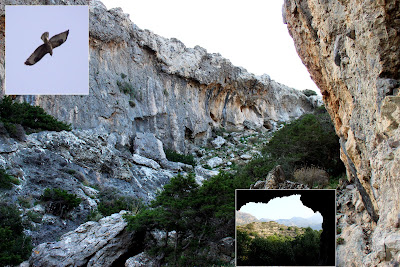As
the first part of our walk today takes us along the road from where
we finished last week I thought we'd make an early start of it to see
if there are any hares or badgers making use of the human highways at
this time in the morning. No sign of any yet but we do have some
wildlife that I suggested that we look out for in the Late
Winter Almanack. Firstly the Pine
Processionary Caterpillars, Thaumetopoea
pityocampa, are
up and about (although these are described as nocturnal in many of
the texts I've often found them reluctant to go back to bed in the
mornings) and secondly, as I was just bending down to photograph this
Storksbill, a little movement in the undergrowth revealed a beautiful
Silver Y moth, Autographa
gamma, which
is one of the migratory moths I mentioned. The little silver markings
in the middle of his wings give him both his English name (being
shaped like the letter Y) and his scientific name (being shaped like
the Greek gamma).
Here's
the track where we diverge from the road and get up in amongst the
Forty Saints once more but there are a couple of wayside flowers to
take note of before we head up into the wilderness. The little mauve
job that I was about to photograph before being distracted by the
Silver Y is the Storksbill and the other is a White Hedge Nettle. I
always think of this as being a rather insecure plant. For a start
it's name is based upon it's nettle like leaves which are just for
show, they contain no sting at all and secondly you always find it
growing up through other plants as if it's afraid to go out on its
own.
This
old ruin seems like a nice place to sit and rest awhile. I can hear
chaffinches, a Sardinian warbler and the first greenfinch of the year
and we may be able to spot them flitting about from the top of those
steps. Meanwhile I seem to be getting infested with tiny beetles.
Their wing cases are a little short and they seem to make quite a job
of tucking their wings in. That, along with their minute size and
their little clubbed antennae identify them as members of the
Nitidulidae
family which includes the Picnic Beetle. These are so named for their
habit of gatecrashing picnics and diving into any alcoholic beverage
that happen to be about. Their usual diet includes decaying fruit as
it begins to ferment, hence their predilection for alcohol. These
chaps however, belong to a different subfamily and are purely pollen
eaters as you can see from that one happily feasting on the chamomile
down there.
We
have three tracks ahead of us and I think that if we take the left
hand one we should be able to return by the middle one and save the
right hand one for another day. A nice choice as there's another of
those cisterns from which we've disturbed rather a nice buzzard.
Which reminds me, we haven't seen our ravens, Huginn and Muninn, this
morning although I did hear them cronking away in the Milonas Valley
as we walked up the road earlier. Probably looking for anything that
didn't make it through the night for their breakfast. Meanwhile we
have another little cavelet if we just push our way through these
carob trees. No signs of recent occupation so if we carefully lower
ourselves down into this juniper filled gully we'll climb to the top
and see what's up there.
A
nice view of the Milonas valley and that defile in the centre hides
the Milonas
waterfall. There are absolutely loads of these tiny little crocus
like flowers up here too but they're not crocuses, they are Romulea
(named after Romulus) from a totally different family. A case of
covergent evolution; they're more closely related to asparagus than
the crocus. We also have a non-native Candelabra Aloe from South
Africa up here behind the pumping station looking somewhat
incongruous. There's a track leading down from the pumping station
and if my calculations are right it should lead us back to the three
way junction. Well, it would have done if someone hadn't erected a
two metre fence across it. Oh well, we will just have to force our
way through the thorny scrub on this side until we come to the end of
it. Not all bad news, at least we've found an interesting little
puddle. Nothing here at the moment but possibly a good place to set
up a camera trap.
I
can see the end of the fence – just the other side of this steep
walled five metre deep gully. There's a small goat path up the other
side but this side is a scramble and slide job. Here goes. Well, that
was interesting but I still seem to have the seat of my trousers
intact and I was right about the track; there's the little ruin where
we met the pollen beetles. Next week we'll see where the third track
leads us.
Photographic
Bit
Many
of you have asked
me
what photographic equipment I use so for details of aperture
settings, shutter speeds etc. my pictures will be on Flickr
within
a few days and that has all the geeky stuff.Pictures
were edited with FastStone Image Viewer and combined with Microsoft
Paint.
*********************************************************************
LINKS:
Share
your nature thoughts, photos and comments on Naturalists
(the
facebook page that accompanies this blog)
Explore
the region with the #CreteNature interactive Hiking
and Nature Map






















